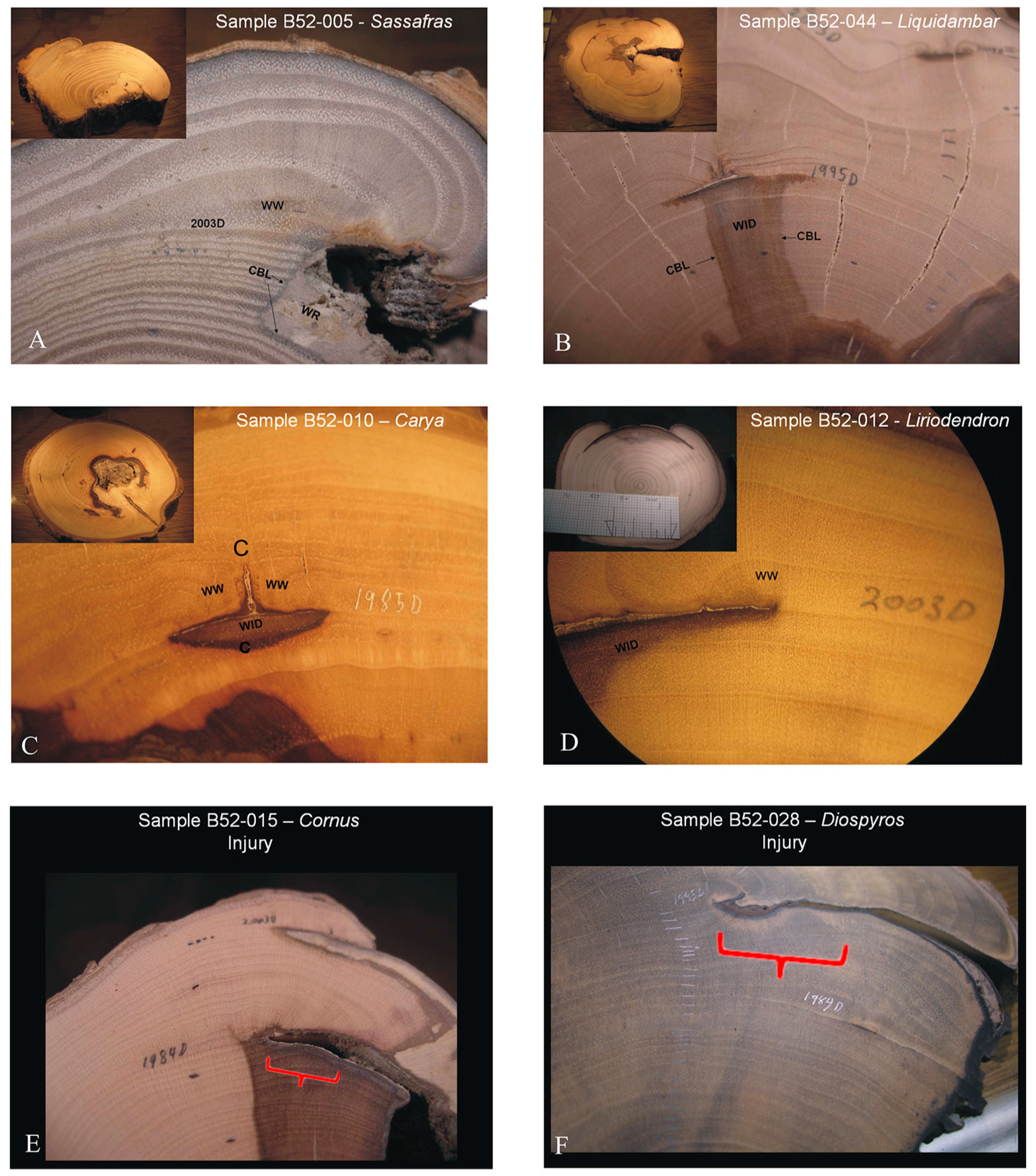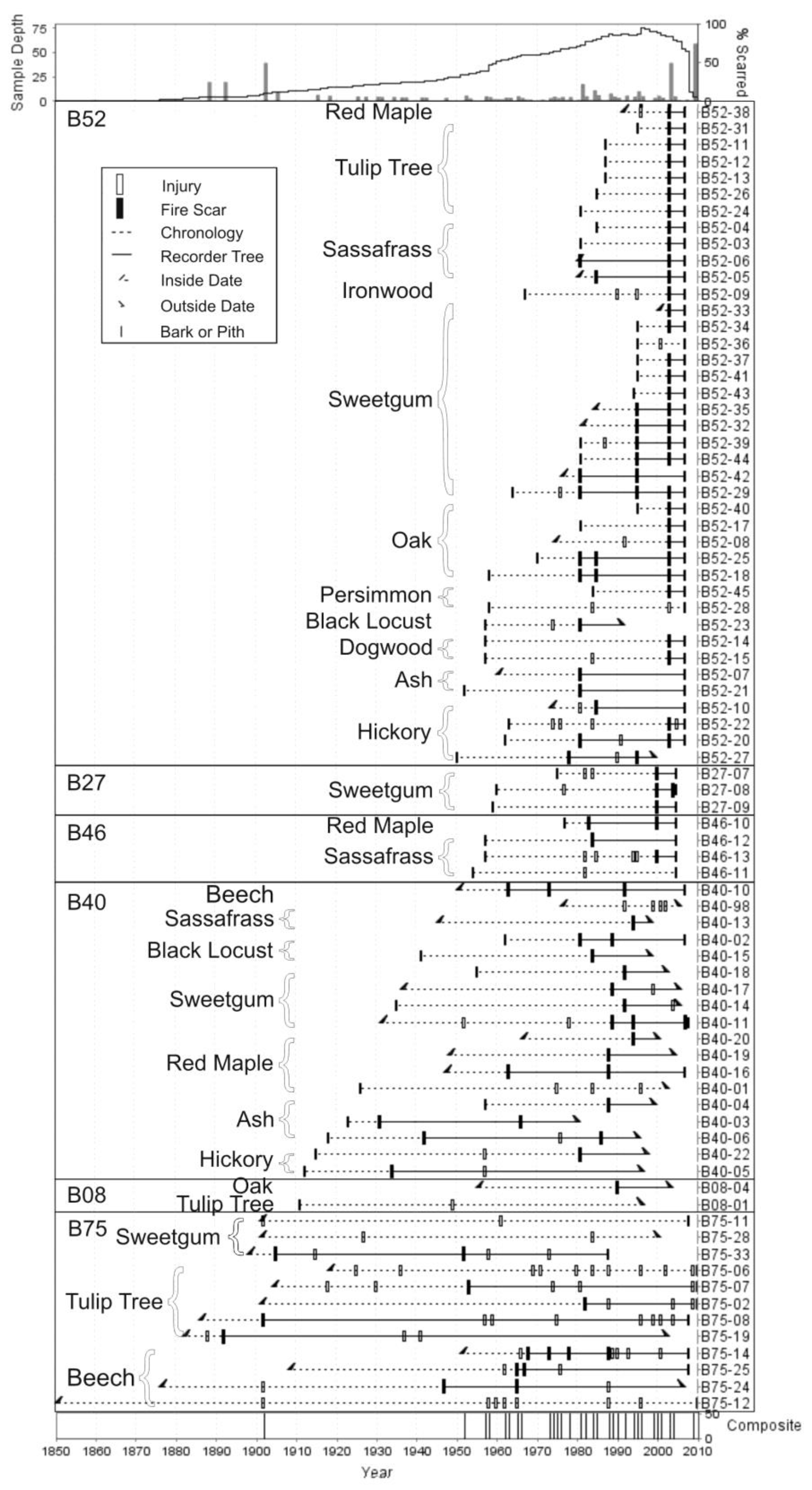The Effect of Fire on Multiple Tree Species in the Eastern Deciduous Forest
Abstract
:1. Introduction
Objectives
2. Materials and Methods
2.1. Study Site
2.2. Field Methods
2.3. Laboratory Methods
3. Results
3.1. Season of Fires and Injuries
3.2. Establishment Dates
4. Discussion
5. Conclusions
Author Contributions
Funding
Institutional Review Board Statement
Informed Consent Statement
Data Availability Statement
Acknowledgments
Conflicts of Interest
References
- Abrams, M.D. Fire history of oak gallery forests in a northeast Kansas tallgrass prairie. Am. Midl. Nat. 1985, 114, 188–191. [Google Scholar] [CrossRef]
- Abrams, M.D. Fire and the development of oak forests. BioScience 1992, 42, 346–353. [Google Scholar] [CrossRef]
- Sutherland, E.K. History of Fire in a Southern Ohio Second-Growth Mixed-Oak Forest; Pallardy, S.G., Cecich, R.A., Garrett, H.E., Johnson, P.S., Eds.; U.S. Department of Agriculture, Forest Service, North Central Forest Experiment Station: St. Paul, MN, USA, 1997; Volume 188, pp. 172–183.
- Smith, K.T.; Sutherland, E.K. Fire-scar formation and compartmentalization in oak. Can. J. For. Res. 1999, 29, 166–171. [Google Scholar] [CrossRef]
- Dey, D.C.; Guyette, R.P. Anthropogenic fire history and red oak forests in south-central Ontario. For. Chron. 2000, 76, 339–347. [Google Scholar] [CrossRef]
- McCarthy, B.C.; Small, C.J.; Rubino, D.L. Composition, structure and dynamics of Dysart Woods, an old-growth mixed mesophytic forest of southeastern Ohio. For. Ecol. Manag. 2001, 140, 193–213. [Google Scholar] [CrossRef]
- Shumway, D.L.; Abrams, M.D.; Ruffner, C.M. A 400-year history of fire and oak recruitment in an old-growth oak forest in western Maryland, U.S.A. Can. J. For. Res. 2001, 31, 1437–1443. [Google Scholar] [CrossRef]
- Guyette, R.P.; Dey, D.C.; Stambaugh, M.C.; Muzika, R.M. Fire scars reveal variability and dynamics of eastern fire regimes. In Fire in Eastern Oak Forests: Delivering Science to Land Managers; Dickinson, M.B., Ed.; Fawcett Center, The Ohio State University: Columbus, OH, USA, 2006; NRS-P-1; pp. 20–39. [Google Scholar]
- Nowacki, G.J.; Abrams, M.D. The demise of fire and “mesophication” of forests in the eastern United States. BioScience 2008, 58, 123–138. [Google Scholar] [CrossRef]
- Arthur, M.A.; Varner, J.M.; Lafon, C.W.; Alexander, H.D.; Dey, D.C.; Harper, C.A.; Horn, S.P.; Hutchinson, T.F.; Keyser, T.L.; Lashley, M.A.; et al. Fire ecology and management in eastern broadleaf and Appalachian forests. In Fire Ecology and Management: Past, Present, and Future of US Forested Ecosystems; Springer: Berlin/Heidelberg, Germany, 2021; pp. 105–147. [Google Scholar] [CrossRef]
- Dee, J.R.; Stambaugh, M.C.; Dey, D.C. Age, growth, longevity, and post-fire/thinning response of chinkapin oak seedlings in a Kansas upland hardwood forest1. J. Torrey Bot. Soc. 2022, 149, 122–134. [Google Scholar] [CrossRef]
- Sutherland, E.K.; Grissino-Mayer, H.D.; Woodhouse, C.A.; Covington, W.W.; Horn, S.; Huckaby, L.; Kerr, R.; Kush, J.; Moorte, M.; Plumb, T. Two centuries of fire in a southwestern Virginia Pinus pungens community. In Proceedings: Inventory and Management in the Context of Catastrophic Events; Myers, W.L., Ed.; Pennsylvania State University: University Park, TX, USA, 1995. [Google Scholar]
- Armbrister, M.R. Changes in Fire Regimes and the Successional Status of Table Mountain Pine (Pinus pungens Lamb.) in the Southern Appalachians, USA. Master’s Thesis, University of Tennessee, Knoxville, TN, USA, 2002. Available online: https://trace.tennessee.edu/utk_gradthes/3293 (accessed on 8 January 2023).
- LaForest, L.B. Fire Regimes of Lower-Elevation Forests in Great Smoky Mountains National Park, Tennessee, USA. Ph.D. Thesis, University of Tennessee, Knoxville, TN, USA, 2012. Available online: https://trace.tennessee.edu/utk_graddiss/1388 (accessed on 8 January 2023).
- Flatley, W.T.; Lafon, C.W.; Grissino-Mayer, H.D.; LaForest, L.B. Fire history and its relation to climate and land use in three southern Appalachian landscapes in the eastern US. Ecol. Appl. 2013, 23, 1250–1266. [Google Scholar] [CrossRef]
- Grissino-Mayer, H.D. Fire as a Once-Dominant Disturbance Process in the Yellow Pine and Mixed Pine-Hardwood Forests of the Appalachian Mountains. In Natural Disturbances and Historic Range of Variation; Springer International Publishing: Berlin/Heidelberg, Germany, 2016; pp. 123–146. [Google Scholar]
- Stambaugh, M.C.; Marschall, J.M.; Abadir, E.R.; Jones, B.C.; Brose, P.H.; Dey, D.C.; Guyette, R.P. Wave of fire: An anthropogenic signal in historical fire regimes across central Pennsylvania, USA. Ecosphere 2018, 9, e02222. [Google Scholar] [CrossRef]
- Marschall, J.M.; Stambaugh, M.C.; Abadir, E.R.; Dey, D.C.; Brose, P.H.; Bearer, S.L.; Jones, B.C. Pre-Columbian red pine (Pinus resinosa Ait.) fire regimes of north-central Pennsylvania, USA. Fire Ecology 2022, 18, 11. [Google Scholar] [CrossRef]
- Smith, K.T.; Sutherland, E.K. Terminology and biology of fire scars in selected central hardwoods. Tree-Ring Res. 2001, 57, 141–147. [Google Scholar]
- Ascoli, D.; Bovio, G. Tree encroachment dynamics in heathlands of north-west Italy: The fire regime hypothesis. Iforest Biogeosci. For. 2010, 3, 137–143. [Google Scholar] [CrossRef]
- Silver, E.J.; Speer, J.H.; Kaye, M.; Reo, N.J.; Howard, L.F.; Anning, A.K.; Wood, S.W.; Wilbur, H.M. Fire history and age structure of an oak-pine forest on Price Mountain, Virginia, USA. Nat. Areas J. 2013, 33, 440–446. [Google Scholar] [CrossRef]
- Gleason, H.A.; Cronquist, A. Manual of Vascular Plants of Northeastern United States and Adjacent Canada, 2nd ed.; The New York Botanical Garden: New York, NY, USA, 1991. [Google Scholar]
- Abrams, M.D. Prescribing fire in eastern oak forests: Is time running out? North J. Appl. For. 2005, 22, 190–196. [Google Scholar] [CrossRef]
- Arno, S.F.; Sneck, K.M. A Method for Determining Fire History in Conifer Forests of the Mountain West; U.S. Department of Agriculture, Forest Service: Washington, DC, USA, 1973; GTR-INT-42; 26p. Available online: https://www.fs.usda.gov/research/treesearch/29572 (accessed on 8 January 2023).
- Speer, J.H. Fundamentals of Tree-Ring Research; The University of Arizona Press: Tucson, AZ, USA, 2010; p. 333. [Google Scholar]
- Orvis, K.H.; Grissino-Mayer, H.D. Standardizing the reporting of abrasive papers used to surface tree-ring samples. Tree-Ring Res. 2002, 58, 47–50. [Google Scholar]
- Grissino-Mayer, H.D. FHX2—Software for analyzing temporal and spatial patterns in fire regimes from tree rings. Tree-Ring Res. 2001, 57, 113–122. [Google Scholar]
- Swetnam, T.W.; Baisan, C.H. Historical fire regime patterns in the southwestern United States since AD 1700. In Fire Effects in Southwestern Forests, Proceedings of the Second La Mesa Fire Symposium, Los Alamos, NM, USA, 29–31 March 1994; Allen, C.D., Ed.; U.S. Department of Agriculture Forest Service: Fort Collins, CO, USA, 1996; RM-GTR-286; pp. 11–32. Available online: https://www.fs.usda.gov/research/treesearch/38455 (accessed on 8 January 2023).
- Hogg, E.H.; Hart, M.; Lieffers, V.J. White tree rings formed in trembling aspen saplings following experimental defoliation. Can. J. For. Res. 2002, 32, 1929–1934. [Google Scholar] [CrossRef]
- Daniels, L.; Dobry, J.; Klinka, K.; Feller, M. Determining year of death of logs and snags of Thuja plicata in southwestern coastal British Columbia. Can. J. For. Res. 1997, 27, 1132–1141. [Google Scholar] [CrossRef]
- Weedon, J.T.; Cornwell, W.K.; Cornelissen, J.H.C.; Zanne, A.E.; Wirth, C.; Coomes, D.A. Global meta-analysis of wood decomposition rates: A role for trait variation among tree species? Ecol. Lett. 2009, 12, 45–56. [Google Scholar] [CrossRef]
- Alexander, M.R.; Rollinson, C.R.; Moore, D.J.; Speer, J.H.; Rubino, D.L. Determination of death dates of coarse woody debris of multiple species in the central hardwood region (Indiana, USA). Tree-Ring Res. 2018, 74, 135–143. [Google Scholar] [CrossRef]
- Provencher, L.; Herring, B.J.; Gordon, D.R.; Rodgers, H.L.; Tanner, G.W.; Hardesty, J.L.; Brennan, L.A.; Litt, A.R. Longleaf pine and oak responses to hardwood reduction techniques in fire-suppressed sandhills in northwest Florida. For. Ecol. Manag. 2001, 148, 63–77. [Google Scholar] [CrossRef]
- Nuttle, T.; Royo, A.A.; Adams, M.B.; Carson, W.P. Historic disturbance regimes promote tree diversity only under low browsing regimes in eastern deciduous forest. Ecol. Monogr. 2013, 83, 3–17. [Google Scholar] [CrossRef]
- Matlack, G.R. Reassessment of the use of fire as a management tool in deciduous forests of eastern North America. Conserv. Biol. 2013, 27, 916–926. [Google Scholar] [CrossRef]
- Stambaugh, M.C.; Varner, J.M.; Noss, R.F.; Dey, D.C.; Christensen, N.L.; Baldwin, R.F.; Guyette, R.P.; Hanberry, B.B.; Harper, C.A.; Lindblom, S.G.; et al. Clarifying the role of fire in the deciduous forests of eastern North America: Reply to Matlack. Conserv. Biol. 2015, 29, 942–946. Available online: https://www.jstor.org/stable/24483128 (accessed on 8 January 2023). [CrossRef]
- Lafon, C.W.; Naito, A.T.; Grissino-Mayer, H.D.; Horn, S.P.; Waldrop, T.A. Fire history of the Appalachian region: A review and synthesis. Forest Service, Southern Research Station, General Technical Report 2017, SRS-219. Available online: https://trace.tennessee.edu/cgi/viewcontent.cgi?article=1014&context=utk_geogpubs (accessed on 8 January 2023).
- Maxwell, R.S.; Hessl, A.E.; Cook, E.R.; Pederson, N. A multispecies tree ring reconstruction of Potomac River streamflow (950–2001). Water Resour. Res. 2011, 47, 1–12. [Google Scholar] [CrossRef]
- Pederson, N.; Bell, A.R.; Cook, E.R.; Lall, U.; Devineni, N.; Seager, R.; Eggleston, K.; Vranes, K.P. Is an Epic Pluvial Masking the Water Insecurity of the Greater New York City Region? J. Clim. 2013, 26, 1339–1354. [Google Scholar] [CrossRef]
- Gibbes, C.; Havlick, D.G.; Robb, J.R. Land use and land cover in a transitioning militarized landscape. J. Land Use Sci. 2017, 12, 182–196. [Google Scholar] [CrossRef]




| Common Name | Scientific Name | Oldest Sample | Number of Trees Dated | Max Fire Scars | Max Injuries | Max Total per Tree | Dated Samples with No Scars | % Samples Scarred |
|---|---|---|---|---|---|---|---|---|
| Red Maple | Acer rubrum | 1926 | 6 | 2 | 3 | 3 | 0 | 100% |
| Ironwood | Carpinus caroliniana | 1967 | 1 | 1 | 2 | 2 | 0 | 100% |
| Shagbark Hickory | Carya ovata | 1912 | 8 | 2 | 4 | 5 | 2 | 75% |
| Flowering Dogwood | Cornus florida | 1956 | 2 | 1 | 2 | 3 | 0 | 100% |
| Persimmon | Diospyros virginiana | 1958 | 2 | 1 | 2 | 3 | 0 | 100% |
| Beech | Fagus grandifolia | 1787 | 6 | 3 | 7 | 7 | 0 | 100% |
| White Ash | Fraxinus americana | 1918 | 5 | 2 | 1 | 3 | 0 | 100% |
| Tulip Tree | Liriodendron tulipifera | 1882 | 12 | 1 | 10 | 10 | 0 | 100% |
| Sweetgum | Liquidambar styraciflua | 1898 | 24 | 3 | 3 | 5 | 1 | 96% |
| White Oak | Quercus alba | 1958 | 3 | 3 | 1 | 3 | 0 | 100% |
| Pin Oak | Quercus palustris | 1995 | 1 | 1 | 0 | 1 | 0 | 100% |
| Red Oak | Quercus rubra | 1911 | 2 | 0 | 1 | 1 | 1 | 50% |
| Black Oak | Quercus velutina | 1970 | 1 | 3 | 0 | 3 | 0 | 100% |
| Black Locust | Robinia pseudoacacia | 1941 | 4 | 2 | 1 | 2 | 1 | 75% |
| Sassafras | Sassafras albidum | 1945 | 9 | 2 | 4 | 5 | 0 | 100% |
Disclaimer/Publisher’s Note: The statements, opinions and data contained in all publications are solely those of the individual author(s) and contributor(s) and not of MDPI and/or the editor(s). MDPI and/or the editor(s) disclaim responsibility for any injury to people or property resulting from any ideas, methods, instructions or products referred to in the content. |
© 2024 by the authors. Licensee MDPI, Basel, Switzerland. This article is an open access article distributed under the terms and conditions of the Creative Commons Attribution (CC BY) license (https://creativecommons.org/licenses/by/4.0/).
Share and Cite
Speer, J.H.; Rubino, D.L.; Robb, J.R. The Effect of Fire on Multiple Tree Species in the Eastern Deciduous Forest. Fire 2024, 7, 22. https://doi.org/10.3390/fire7010022
Speer JH, Rubino DL, Robb JR. The Effect of Fire on Multiple Tree Species in the Eastern Deciduous Forest. Fire. 2024; 7(1):22. https://doi.org/10.3390/fire7010022
Chicago/Turabian StyleSpeer, James H., Darrin L. Rubino, and Joseph R. Robb. 2024. "The Effect of Fire on Multiple Tree Species in the Eastern Deciduous Forest" Fire 7, no. 1: 22. https://doi.org/10.3390/fire7010022
APA StyleSpeer, J. H., Rubino, D. L., & Robb, J. R. (2024). The Effect of Fire on Multiple Tree Species in the Eastern Deciduous Forest. Fire, 7(1), 22. https://doi.org/10.3390/fire7010022






